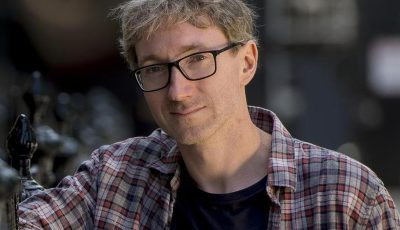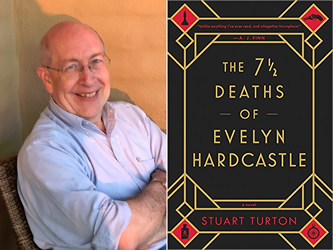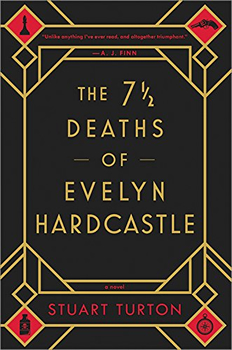

Neil Nyren’s Spotlight: Stuart Turton
Writing a Novel Most Intricate
 This may very well be the twistiest, most intricate crime novel you’ll read this year. A tall order, I know, given the competition, but trust me on this. The author, Stuart Turton, calls it “an Agatha Christie mystery in a Groundhog Day loop, with a bit of Quantum Leap.” Others have invoked Gosford Park, Inception, and “Downton Abbey with a body count.”
This may very well be the twistiest, most intricate crime novel you’ll read this year. A tall order, I know, given the competition, but trust me on this. The author, Stuart Turton, calls it “an Agatha Christie mystery in a Groundhog Day loop, with a bit of Quantum Leap.” Others have invoked Gosford Park, Inception, and “Downton Abbey with a body count.”
THE 7 ½ DEATHS OF EVELYN HARDCASTLE opens with the narrator waking up in a remote forest, wearing someone else’s dinner jacket and, he realizes, someone else’s body. Making his way to a large country house, he discovers a party in full swing and a masked figure who informs him that a murder will be committed that night, “but it won’t look like a murder,” and that it will be his responsibility to solve it: “Rectify that injustice and I’ll show you the way out.”
In order to do so, he will have the opportunity to relive the day eight different times in the bodies of eight different people, all with drastically varying perspectives and facts in hand, but if he fails…he’ll have to start all over again. Meanwhile, there are other people at the party with the same directive, all equally desperate to do whatever it takes to get free. Worst of all, there is someone stalking every one of them, killing them one by one. Every move the narrator makes, every clue he uncovers, may be a step forward — or a step closer to the abyss.
And that only scratches the surface of the book’s complexities, the strict — but fair — rules governing its plot and characters, and the mayhem that emerges when things start to go just slightly haywire. The result is both thrilling and absolutely addictive — but how in the world did the author even dream up such a thing?
“I wish there had been an inspiration, but this book collected in my mind like sediment over a period of about 10 years. I grew up reading Agatha Christie, and I’d always wanted to write that style of book, with the big country house and suspicious guests. I had my first crack at it when I was 21, and it was truly, truly dreadful. God, I’m cringing just thinking about it.
The problem was that I didn’t have anything unique to add — I was just remixing all her plots and characters. So I put it aside, waiting for inspiration to strike. I figured it would be a week. Or a month. Definitely not a year, and certainly not 10 years. I became a journalist, and then suddenly, on a redeye flight, my mind went back to the idea and I found all the Groundhog Day/body-hopping stuff plastered over the top. That was that. I had my book. I just had to write the damn thing.”
Much easier said than done. “It was utter sod to write. I planned the entire day in two-minute intervals on a huge spreadsheet, so I knew where every character in the house would be at all times. I had huge notebooks detailing each character’s personality and quirks, which I’d be madly filling at 2 a.m. after an idea hit. And then there were the Post-It notes. I might as well have bought the company that made them; it would have been cheaper. They ended up covering two walls of my office. In total, planning took three months and writing three years, including six months of intense editing.”
Did he ever reach a point when he thought, Oh God, this plot point doesn’t work, and now I’ll have to go back and rearrange everything?
“Only once. About seven months into the writing, I had a brilliant idea that hadn’t been in the plan. I figured, ‘What’s the harm?’ and just stuck it in. That, of course, led to another ‘great’ idea and another. A few months later, the book was a complete mess, and utterly unrecoverable. I tried to make all the new stuff work. I rearranged chapters, messed with the plot, but, ultimately, I realized I was trying to cheat the reader.
 This entire book is a magic trick, and it’s an honest one. Every clue is placed in front of the reader. Nobody suddenly appears in a place they couldn’t get to. I realized that if I cheated and somebody noticed, the entire trick fell apart. In the end, I tossed away 40,000 words of the book and went back to my original plan. After that, I only indulged new ideas that fit the timeline.
This entire book is a magic trick, and it’s an honest one. Every clue is placed in front of the reader. Nobody suddenly appears in a place they couldn’t get to. I realized that if I cheated and somebody noticed, the entire trick fell apart. In the end, I tossed away 40,000 words of the book and went back to my original plan. After that, I only indulged new ideas that fit the timeline.
“The plan was gospel. The only thing that came close to surprise was some of the horror that crept in there. I wasn’t expecting the story to be as unsettling as it became. I didn’t even realize I’d done it until my editor pointed out how creepy parts of it were!”
The “plan” also encompassed which characters the narrator (whose name we finally learn is Aiden Bishop) needed to inhabit, and when. “I chose the order of the hosts as a method of pacing the book, primarily. If I needed the book to speed up, I stuck Aiden in the body of a headstrong young man who’d be reckless and stupid. If I wanted to slow things down and make it a touch more philosophical, I’d put him in the body of an older character, who was physically slower, but much wiser. Lord Ravencourt, for instance. He’s obese, and Aiden’s very unkind about his size at first and that’s born out of frustration — he wants to be moving much more quickly than he can in that body. But I loved how he realizes how sharp Ravencourt’s mind is, and how quickly it lets him solve these problems no other character could.”
I was curious as to what Turton had been doing all that time that the book was collecting in his mind “like sediment.” From the look of his bio, that red-eye flight on which the idea for the book finally came together was far from his first, but I had no idea how far.
“I started traveling in my summers during college (Africa and Central America) and got the bug for rattling buses and not washing often enough. After college ended, I told my parents I was going backpacking for six months around South America and Asia, then lost track of time. I stayed away for, erm, five years instead. Sorry, Mum! For the last year of that period, I was living in Shanghai. That was phenomenal. Even getting on a bus was an adventure. I once caught a train 120 miles in the wrong direction without realizing.”
He continues: “When I came back to England, I worked in a call center for three months to save money, then backpacked around Australia for a year, where I cleaned toilets in private airports, picked fruit, worked in second-hand bookstores, and learned how to put up drywall on a building site. It got to the point where I was taking any job I could just to keep going — even if I was lying point-blank about my experience.
“In the end, I came back to London because my friends were all successful and professional, and I was still eating soup out of tins. I became a technology journalist, which was great, because I could explore Europe really easily, but I ended up taking a sabbatical to travel around the Middle East and ultimately moved to Dubai to become a travel journalist. That was the best job. I spent two weeks of every month going to tropical islands and having adventures in jungles and national parks. I did nearly die in a diving accident, which was a bit unnerving, but I met my wife as a result — which is a brilliant ‘how we met’ story. We’ve got a little girl now. We’ve got a big list of countries we want to show her when she gets older. Cannot wait.”
And then came another adventure, one that can be unnerving in itself — the odyssey of trying to find an agent, and then a publisher. In that, he was lucky, “thanks mostly to being a dumbass. When I started writing THE 7 ½ DEATHS OF EVELYN HARDCASTLE, I just kind of assumed it would be published and left it at that. About three months before I finished it, I started researching how to get published and that’s the first time I realized how difficult the entire process was, and how unlikely it would be the book would sell, or even find an agent.
“In a panic, I started Googling agents who would take my type of book, and the list was vanishingly thin. I submitted to five, and thankfully had a couple of offers of representation. In the end, I settled on Harry Illingworth at DHH, mainly because he got the book and is a very nice chap, if ridiculously tall. Honestly, I’m worried one day somebody’s going to climb his beanstalk and cut his head off.
“And then Bloomsbury acquired it at auction. The book was published in the U.K. in March and the reception was wonderful. Sales have been superb and it’s been praised across the board. We’ve been nominated for a few prizes as well (including the long list of one of the U.K. Crime Writers Association’s prestigious Dagger Awards). That’s a really nice ego boost after three years writing a book that you worry nobody will like. My most memorable experience was when I was signing copies in a bookstore and an old lady told me off because she thought I was some stranger off the street vandalizing the books! She bought three copies to apologize.”
There was one hitch, though, when it came to the U.S. edition. If you look it up, you’ll see that the title of the book in the U.K. is THE 7 DEATHS OF EVELYN HARDCASTLE, but then, by an “incredibly unlucky coincidence,” a book came out in the U.S. in January titled The Seven Husbands of Evelyn Hugo. And so, to avoid confusion, poor Evelyn Hardcastle had to die one-half time more. Which she seems to have borne quite well, as has the author. He credits it all to the pure pleasure he discovered in every confounding, frustrating, beautiful aspect of creating, writing, editing, and publishing. What did he love most about it?
“Everything. Every single thing. I love that first blank page, finding that perfect first line, the moment your character says something unexpected and you realize they’re a proper character. I love when it takes over a part of your brain, and sits there, like a puzzle you’re always working on, even while you’re talking with friends or eating dinner with your wife. I love talking to people who’ve read my book, and hearing their theories. I love beautiful writing, lines so good they bug you a week later. I love the collaborative spirit of editing, and the joy of a good metaphor. Everything. Every moment. Wouldn’t change a thing.”
And from the sound of it, he won’t have to. His next book is a secret — “I’d love to tell you about it, but it’ll probably be so different by the time I finish it, that it would seem like I lied to you” — but there is no doubt it will be infused with the same audacity and dazzle that fills every page of the first one.
*****
Stuart Turton is a freelance travel journalist who has previously worked in Shanghai and Dubai. THE 7 ½ DEATHS OF EVELYN HARDCASTLE is his debut novel. He is the winner of the Brighton and Hove Short Story Prize and was longlisted for the BBC Radio 4 Opening Lines competition. He lives in London with his wife.
Neil Nyren retired at the end of 2017 as the Executive VP, associate publisher and editor in chief of G. P. Putnam’s Sons. He is the winner of the 2017 Ellery Queen Award from the Mystery Writers of America. Among his authors of crime and suspense were Clive Cussler, Ken Follett, C. J. Box, John Sandford, Robert Crais, Jack Higgins, W. E. B. Griffin, Frederick Forsyth, Randy Wayne White, Alex Berenson, Ace Atkins, and Carol O’Connell. He also worked with such writers as Tom Clancy, Patricia Cornwell, Daniel Silva, Martha Grimes, Ed McBain, Carl Hiaasen, and Jonathan Kellerman.
He is currently writing a monthly publishing column for the MWA newsletter The Third Degree, as well as a regular ITW-sponsored series on debut thriller authors for BookTrib.com, and is an editor at large for CrimeReads.
This column originally ran on Booktrib, where writers and readers meet:
- THE GOD IN THE SEA with Paul Kemprecos - April 4, 2024
- FOR WORSE with L. K. Bowen - April 4, 2024
- HIT AND RUN with Vincent Zandri - April 4, 2024


